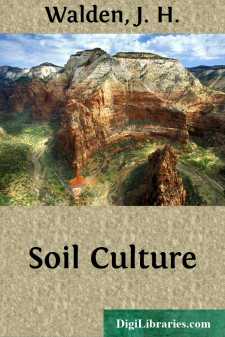Categories
- Antiques & Collectibles 13
- Architecture 36
- Art 48
- Bibles 22
- Biography & Autobiography 813
- Body, Mind & Spirit 142
- Business & Economics 28
- Children's Books 17
- Children's Fiction 14
- Computers 4
- Cooking 94
- Crafts & Hobbies 4
- Drama 346
- Education 46
- Family & Relationships 57
- Fiction 11829
- Games 19
- Gardening 17
- Health & Fitness 34
- History 1377
- House & Home 1
- Humor 147
- Juvenile Fiction 1873
- Juvenile Nonfiction 202
- Language Arts & Disciplines 88
- Law 16
- Literary Collections 686
- Literary Criticism 179
- Mathematics 13
- Medical 41
- Music 40
- Nature 179
- Non-Classifiable 1768
- Performing Arts 7
- Periodicals 1453
- Philosophy 64
- Photography 2
- Poetry 896
- Political Science 203
- Psychology 42
- Reference 154
- Religion 513
- Science 126
- Self-Help 84
- Social Science 81
- Sports & Recreation 34
- Study Aids 3
- Technology & Engineering 59
- Transportation 23
- Travel 463
- True Crime 29
Soil Culture
by: J. H. Walden
Description:
Excerpt
ACCLIMATION.
This is the art of successfully changing fruits or plants from one climate to another. Removal to a colder climate should be effected in the spring, and to a warmer one in the fall. This may be done by scions or seeds. By seeds is better, in all cases in which they will produce the same varieties. Very few imported apple or pear trees are valuable in this country; while our finest varieties, perfectly adapted to our climate, were raised from seeds of foreign fruits and their descendants. The same is true of the extremes of this country. Baldwin apple-trees, forty or fifty years old, are perfectly hardy in the colder parts of New England; while the same imported from warmer sections of the Union fail in severe winters. This fact has given many new localities the reputation of being poor fruit-regions. When we remove fruit-trees to a similar climate in a new country, they flourish well, and we call it a good fruit-country. Remove trees from the same nursery to a different climate and soil, and they are not hardy and vigorous, and we call it a poor fruit-country. These two localities may be equally good for fruit, with suitable care in acclimating the tree and preparing the soil. Thus the rich prairies of central Illinois are often said not to be adapted to fruit. Give time to raise fruits from the seed, and to apply the principles of acclimation, and those rich prairies will be among the great fruit-growing regions of the world. Two things are essential to successful fruit-culture, on all the alluvial soils of the Northwest: raise from seed, and prune closely and head-in short, and thus put back and strengthen the trees for the first ten years, and no more complaints will be heard.
The peach has been gradually acclimated, until, transplanted from perpetual summer, it successfully endures a temperature of thirty-five degrees below zero. This prince of fruits will yet be successfully grown even beyond the northern limits of Minnesota. Many vegetables may also be grown in very different climates, by annually importing the seed from localities where they naturally flourish. Sweet potatoes are thus grown abundantly in Massachusetts. We wonder this subject has received so little attention. We commend these brief hints to the earnest consideration of all practical cultivators, hoping they may be of great value in the results to which they may lead.
ALMONDS.
Almonds are natives of several parts of Asia and Africa. They perfectly resemble the peach in all but the fruit. The peach and almond grow well, budded into each other. In France, almond-stocks are preferred for the peach. Their cultivation and propagation are in all respects the same as the peach.
Varieties.—1. Long, hard shell. This is the best for cultivation in western and middle states, and in all cold regions. Very ornamental.
2. Common sweet. Productive in middle states, but not so good as the first.
3. Ladies' thin shell. Fruit large, long, and sweet; the very best variety, but not so hardy as the first two. Grows well in warm locations, with slight protection in winter.
4. The bitter. Large, with very ornamental leaves and blossoms. Fruit bitter, and yielding that deadly poison, prussic acid.
5. Peach almond. So called from having a pulp equal to a poor peach. Not hardy in northern climates. Other varieties are named, but are of no consequence to the practical cultivator.
6. Two varieties of ornamental almonds are very beautiful in spring—the large, double flowering, and the well-known dwarf flowering. But we regard peach-blossoms quite as ornamental, and the ripe peaches much more so, and so prefer to cultivate them.
Almonds are extensively cultivated in the south of Europe, especially in Portugal, as an article of commerce. They will grow equally well in this country; but labor is so cheap in Europe, that American cultivators can not compete with it in the almond market. But every one owning land should cultivate a few as a family luxury.
APPLES.
The original of all our apples was the wild European crab. We have in this country several native crabs larger and better than the European; but they have not yet, as we are aware, been developed into fine apples....


